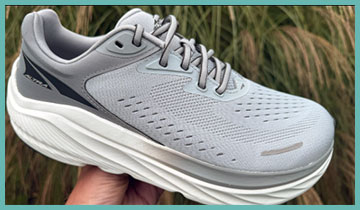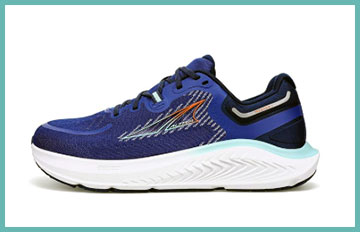I’ve been running for years, chasing that perfect blend of comfort, performance, and durability in a shoe.
When it came to choosing between the Altra Via Olympus 2 and the Altra Paradigm 7, I found myself at a crossroads.
Both are standout options from Altra, a brand known for its zero-drop platforms and wide toe boxes, but they cater to different needs.
In this article, I’ll share my experience testing these shoes, breaking down their key features, pros, and cons, and comparing them head-to-head to help you decide which one fits your running style.
Comparison Table: Altra Via Olympus2 Vs. Paradigm7
| Feature | Altra Via Olympus 2 | Altra Paradigm 7 |
| Type | Neutral Daily Trainer | Max Cushioned Stability Trainer |
| Stack Height | 33mm (Heel and Forefoot) | 30mm (Heel and Forefoot) |
| Drop | Zero Drop | Zero Drop |
| Midsole | Altra EGO Max (EVA-based foam) | Altra EGO Max (EVA and TPU blend) |
| Outsole | Rubber with cutouts for flexibility | Rubber with Footpod Technology |
| Weight | 9.0 oz (Women’s size 7) | 8.8 oz (Women’s size 7) |
| Upper | Engineered mesh, wide toe box | Engineered mesh, standard FootShape |
| Stability Features | Rocker shape for smooth transitions | GuideRails (medial and lateral) |
| Best For | Long, easy/recovery runs | Daily runs with mild stability needs |
| Price | $165 | $170 |
My First Steps With Altra’s Zero-Drop Philosophy
When I first slipped into a pair of Altra shoes, the zero-drop design felt like a revelation. Unlike traditional running shoes with a raised heel, Altra’s zero-drop platform keeps the heel and forefoot at the same height, promoting a natural midfoot strike.
Both the Via Olympus 2 and Paradigm 7 embrace this philosophy, but they deliver it in distinct ways. The Olympus is a neutral daily trainer built for plush comfort, while the Paradigm leans into stability for runners needing a touch of support. My goal was to understand how these differences play out on the road.
Altra Via Olympus 2: The Cloud-Like Cruiser

The Via Olympus 2 felt like stepping into a pillow the first time I laced it up. With a towering 33mm stack height, it’s Altra’s tallest shoe, designed for runners who prioritize cushioning for long, easy miles. The Altra EGO Max midsole, an EVA-based foam, delivers a soft yet responsive ride. I noticed this immediately during a 10-mile recovery run—my legs felt fresh even after a tough week of training.
The rocker shape of the Olympus encourages smooth transitions from heel to toe, which I found especially helpful when fatigue set in. Its wide toe box, a hallmark of Altra’s Original FootShape, gave my toes room to splay naturally, reducing pressure on longer runs. However, at 9 ounces (women’s size 7), it’s not the lightest shoe, and I felt a slight drag when pushing the pace on faster runs.
The upper, made of engineered mesh, is breathable and accommodating, hugging my midfoot securely while leaving plenty of room up front. The heel counter struck a balance—not too stiff, not too soft—keeping my foot locked in without irritation. I also appreciated the reflective strip on the lateral side for evening runs, a small but thoughtful touch.
One downside? The outsole, while durable, has less rubber coverage than I’d like for a shoe at this price point ($165). On wet surfaces, traction was decent but not exceptional, scoring a 0.55 in wet-condition tests according to Running Shoes Guru. For runners in rainy climates, this might be a consideration.
Pros of the Via Olympus 2
- Plush cushioning ideal for recovery and long runs.
- Wide toe box promotes natural foot movement.
- Rocker shape aids smooth transitions.
- Breathable upper enhances comfort.
- Reflective elements for low-light visibility.
Cons of the Via Olympus 2
- Heavy at 9 ounces, not ideal for speedwork.
- Limited outsole rubber reduces traction on wet surfaces.
- Slightly pricey at $165.
- Flimsy tongue lacks structure, which may bother some runners.
Altra Paradigm 7: The Stable Workhorse

Switching to the Paradigm 7, I immediately noticed its focus on stability. With a 30mm stack height and the same EGO Max midsole (a blend of EVA and TPU), it feels slightly firmer than the Olympus, offering a balance of cushioning and responsiveness. The midsole’s durometer measured 19.4 HA, indicating a comfy but not overly soft feel, which I appreciated on daily runs.
The Paradigm’s standout feature is its GuideRail system, with a larger medial rail and a smaller lateral one. These adaptive rails engage when my foot starts to overpronate, providing subtle support without feeling intrusive. As someone with mild pronation, I found this system effective during a 12-mile run, where my form stayed consistent even as I tired.
The upper, built on Altra’s Standard FootShape last, is slightly less roomy than the Olympus but still allows for toe splay. The redesigned mesh is breathable and flexible, and the plush tongue and heel collar eliminated the tongue slippage issues from earlier models. The outsole, equipped with Footpod Technology and Innerflex slits, promotes natural foot flex and durability, handling both dry and wet roads well with a 0.55 wet-condition score.
At $170, the Paradigm is pricier than the Olympus, and its energy return (43% per ASTM F1976 standards) is lackluster compared to competitors like the Hoka Carbon X. It’s also not built for speed, feeling clunky during tempo runs. Still, its stability and comfort make it a reliable choice for daily training.
Pros of the Paradigm 7
- GuideRail system offers effective, non-intrusive stability.
- Durable outsole with Footpod Technology for natural movement.
- Plush, breathable upper enhances comfort.
- Ideal for runners with mild overpronation.
- True-to-size fit with 51 votes confirming consistency.
Cons of the Paradigm 7
- Higher price point at $170.
- Low energy return (43%) limits responsiveness.
- Not suited for tempo or speed training.
- Slightly firm in cold weather, reducing comfort.
Read More: My Thoughts On Asics Cumulus Vs. GT 2000
Head-To-Head: How They Stack Up
Comparing the Via Olympus 2 and Paradigm 7 is like choosing between a cozy couch and a supportive recliner—both are comfortable, but their purposes differ. The Olympus, with its 33mm stack and softer EGO Max foam, feels like running on clouds, perfect for recovery runs or long, easy miles. Its rocker shape makes transitions effortless, especially when my legs are fatigued. The Paradigm, with a 30mm stack and firmer foam, sacrifices some plushness for stability, thanks to its GuideRail system. It’s my go-to for daily runs when I need a bit more control.
Weight is a close call—9 ounces for the Olympus versus 8.8 ounces for the Paradigm. Neither is lightweight, so if you’re chasing speed, you might look elsewhere, like Altra’s Torin 7. The Olympus’s wider toe box (Original FootShape) feels more spacious than the Paradigm’s Standard FootShape, which could sway runners with wider feet.
Traction is comparable, with both scoring 0.55 in wet conditions, but the Paradigm’s Footpod Technology gives it a slight edge for durability. Price-wise, the Olympus ($165) is marginally cheaper than the Paradigm ($170), but both feel steep for their performance compared to competitors like the Hoka Clifton 9.
My Experience on the Road
To get a real feel for these shoes, I took them through a variety of runs—recovery jogs, long runs, and even a few tempo efforts (though neither shoe loves speed). On a 15-mile long run, the Olympus was a dream. Its plush cushioning absorbed the impact of each step, and the wide toe box let my feet spread naturally, preventing the tightness I sometimes feel in narrower shoes. The rocker shape kept my stride smooth, even at mile 12 when my form started to slip.
The Paradigm shone on a 10-mile daily run with mixed terrain—pavement, gravel, and a bit of wet asphalt. The GuideRails kept my pronation in check, and the outsole gripped well, though I wished for more rubber on slick surfaces. The firmer midsole gave me confidence in my stride, but I missed the Olympus’s softness on longer stretches.
One surprise was how differently they handled fatigue. The Olympus felt forgiving, almost encouraging me to keep going, while the Paradigm’s stability made me feel secure but less cushioned. If I had to pick for a marathon, I’d lean toward the Olympus for its comfort over long distances, but the Paradigm would be my choice for consistent daily training.
Who Are These Shoes For?
The Via Olympus 2 is your match if you’re a neutral runner who loves long, easy runs or needs a recovery shoe after intense sessions. Its plush cushioning and wide toe box make it ideal for runners with wider feet or those transitioning to zero-drop shoes. Ultrarunners like Ryan Montgomery, who finished second at the 2021 Javelina 100 in the Via Olympus, prove its durability for extreme distances.
The Paradigm 7 suits runners with mild overpronation who want a stable, cushioned daily trainer. Its GuideRail system and firmer midsole cater to those needing support without sacrificing Altra’s natural foot shape. It’s also a great entry point for newcomers to zero-drop running, offering stability to ease the transition.
The Altra Brand: Why It Stands Out
Altra’s commitment to zero-drop and FootShape design sets it apart in a crowded market. Both the Olympus and Paradigm embody this ethos, promoting a natural gait that aligns your foot, knee, and hip joints. As someone who’s dealt with shin splints from heel-striking in traditional shoes, I appreciate how Altra’s design encourages a midfoot strike, reducing impact stress.
The brand’s focus on toe splay also resonates with me. After years of squeezing my feet into narrow toe boxes, Altra’s roomy fit feels liberating. However, the zero-drop learning curve can be steep if you’re used to a higher heel-to-toe drop. I needed a few weeks to adjust my calves and Achilles to the flatter platform, but the payoff was worth it.
The Verdict: Which Should You Choose?
Choosing between the Via Olympus 2 and Paradigm 7 depends on your running goals. If you’re logging long, slow miles or recovering from hard efforts, the Olympus’s plush cushioning and rocker shape will carry you comfortably. If you need stability for daily runs or have mild pronation, the Paradigm’s GuideRails and firmer midsole offer reliable support.
For me, the Olympus edges out slightly for its cloud-like feel, especially on recovery days. But the Paradigm’s versatility makes it a close contender for everyday training. Whichever you choose, both shoes embody Altra’s mission to let your feet move naturally. Try them on, take a few runs, and see which one feels like home for your stride.
Read More: My Thoughts On Adidas Samba Vs. Samoa
Frequently Asked Questions (FAQ)
The Via Olympus is ideal for long, easy runs and recovery sessions, offering plush cushioning and a wide toe box for comfort.
The Paradigm 7 is Altra’s most supportive shoe, featuring GuideRails for mild overpronation and a stable ride.
The Paradigm 7 is a stability shoe, designed with GuideRails to support runners with mild overpronation.
Yes, the Via Olympus 2 is a zero-drop shoe, with equal 33mm stack height in the heel and forefoot.
Conclusion: Your Run, Your Choice
You’re out there pounding the pavement, chasing goals, and searching for a shoe that feels like an extension of your stride. I’ve run countless miles in the Altra Via Olympus 2 and Paradigm 7, and both have their strengths. The Olympus wraps your feet in plush comfort, perfect for long runs or recovery days, while the Paradigm offers stability and reliability for daily training. Consider your needs—cushioning or support, long runs or consistent miles—and pick the one that aligns with your journey. Whichever you choose, Altra’s natural design will keep you running true to form.
